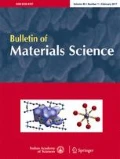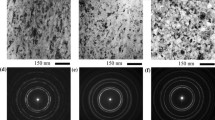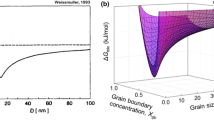Abstract
The present article reviews the current status of research and development on the structure and properties of nanocrystalline materials. Nanocrystalline materials are polycrystalline materials with grain sizes of up to about 100 nm. Because of the extremely small dimensions, a large fraction of the atoms in these materials is located at the grain boundaries, and this confers special attributes. Nanocrystalline materials can be prepared by inert gas-condensation, mechanical alloying, plasma deposition, spray conversion processing, and many other methods. These have been briefly reviewed.
A clear picture of the structure of nanocrystalline materials is emerging only now. Whereas the earlier studies reasoned out that the structure of grain boundaries in nanocrystalline materials was quite different from that in coarse-grained materials, recent studies using spectroscopy, high-resolution electron microscopy, and computer simulation techniques showed unambiguously that the structure of the grain boundaries is the same in both nanocrystalline and coarse-grained materials. A critical analysis of this aspect and grain growth is presented.
The properties of nanocrystalline materials are very often superior to those of conventional polycrystalline coarse-grained materials. Nanocrystalline materials exhibit increased strength/hardness, enhanced diffusivity, improved ductility/toughness, reduced density, reduced elastic modulus, higher electrical resistivity, increased specific heat, higher thermal expansion coefficient, lower thermal conductivity, and superior soft magnetic properties in comparison to conventional coarse-grained materials. Recent results on these properties, with special emphasis on mechanical properties, have been discussed.
New concepts of nanocomposites and nanoglasses are also being investigated with special emphasis on ceramic composites to increase their strength and toughness. Even though no components made of nanocrystalline materials are in use in any application now, there appears to be a great potential for applications in the near future. The extensive investigations in recent years on structure-property correlations in nanocrystalline materials have begun to unravel the complexities of these materials, and paved the way for successful exploitation of the alloy design principles to synthesize better materials than hitherto available.
Similar content being viewed by others
References
Anantharaman T R and Suryanarayana C 1987Rapidly solidified metals: A technological overview (Aedermannsdorf, Switzerland: Trans Tech Publ.)
Andres R Pet al 1989J. Mater. Res. 4 704
Andrievski R A 1994J. Mater. Sci. 29 614
Armstrong R W 1983 inYield, flow and fracture of polycrystals (ed) T N Baker (London: Appl. Sci. Pub) p. 1
Averback R S, Hahn H, Höfler H J, Logas J L and Chen T C 1989Mater. Res. Soc. Symp. Proc. 158 3
Averback R S, Höfler H J and Tao R 1993Mater. Sci. Engg. A166 169
Baibich N Bet al 1988Phys. Rev. Lett. 61 2472
Bakonyi I, Toth-Kadar E, Tarnoczi T, Varga L, Cziraki A, Gerocs I and Fogarassy B 1993Nanostr. Mater. 3 155
Beck D D and Siegel R W 1992J. Mater. Res. 7 2840
Benjamin J S 1976Sci. Am. 234 40
Berkowitz A E and Walter J L 1987J. Mater. Res. 2 277
Berkowitz A Eet al 1992Phys. Rev. Lett. 68 3745
Bickerdike R L, Clark D, Easterbrook J N, Hughes G, Mair W N, Partridge P G and Ranson H C 1984–85Int. J. Rapid Solidification 1 305
Birringer R 1989Mater. Sci. Engg. A117 33
Birringer R, Gleiter H, Klein H P and Marquart P 1984Phys. Lett. A102 365
Birringer R, Herr U and Gleiter H 1986Suppl. Trans. Jpn. Inst. Metals 27 43
Birringer R, Hahn H, Höfler H J, Karch J and Gleiter H 1988Defect & Diff. Forum 59 17
Boylan K, Ostrander D, Erb U, Palumbo G and Aust K T 1991Scr. Metall. Mater. 25 2711
Bush M B 1993Mater. Sci. Engg. A161 127
Chang H, Altstetter C J and Averback R S 1992J. Mater. Res. 7 2962
Chen L C and Spaepen F 1988Nature (London) 336 366
Cho Y S and Koch C C 1991Mater. Sci. Engg. A141 139
Chokshi A H, Rosen A, Karch J and Gleiter H 1989Scr. Metall. 23 1679
Chou C-H and Phillips J 1992J. Mater. Res. 7 2107
Christman T 1993Scr. Metall. Mater. 28 1495
Coble R L 1963J. Appl. Phys. 34 1679
Cottrell A H 1992Metals & Mater. 8 10
Cowen J A, Stolzmann B, Averback R S and Hahn H 1987J. Appl. Phys. 61 3317
Dagani R 1992Chem. & Engg. News 70 18
El-Kaddah N (ed) 1992Thermal plasma applications in materials and metallurgical processing (Warrendale, PA: TMS)
El-Sherik A M, Erb U, Palumbo G and Aust K T 1992Scr. Metall. Mater. 27 1185
Feynman R 1991Science 254 1300
Fougere G E, Weertman J R, Siegel R W and Kim S 1992Scr. Metall. Mater. 26 1879
Fougere G E, Weertman J R and Siegel R W 1993Nanostr. Mater. 3 379
Froes F H and Suryanarayana C 1989JOM 41 12
Ganapathi S K and Rigney D A 1990Scr. Metall. Mater. 24 1675
Ganapathi S K, Owen D M and Chokshi A H 1991Scr. Metall. Mater. 25 2699
Gertsman V Y and Birringer R 1994Scr. Metall. Mater. 30 577
Gleiter H 1981 inDeformation of polycrystals: Mechanisms and microstructures, (eds) N Hansen, A Horsewell, T Leffers and H Lilholt (Roskilde, Denmark: Riso National Laboratory) pp. 15–21
Gleiter H 1989Prog. Mater. Sci. 33 223
Gleiter H 1992Nanostr. Mater. 1 1
Groza J R 1994Scr. Metall. Mater. 30 47
Gryaznov V G, Solov’ev V A and Trusov L I 1990Scr. Metall. Mater. 24 1529
Gryaznov V G, Tanakov M Yu and Trusov L I 1992J. Mater. Sci. 27 4829
Gryaznov V G, Gutkin M Yu, Romanov A E and Trusov L I 1993J. Mater. Sci. 28 4359
Guermazi M, Höfler H J, Hahn H and Averback R S 1991J. Am. Ceram. Soc. 74 2672
Haas V, Gleiter H and Birringer R 1993Scr. Metall. Mater. 28 721
Hahn H, Höfler H J and Averback R S 1989Defect & Diff. Forum 66–69 549
Hahn H, Logas J and Averback R S 1990J. Mater. Res. 5 609
Hall E O 1951Proc. Phys. Soc. (London) B64 747
Hellstern E, Fecht H, Fu Z and Johnson W L 1989J. Appl. Phys. 65 305
Herzer G 1990IEEE Trans. MAG26 1397
Herzer G 1991Mater. Sci. Engg. A133 1
Herzer G and Warlimont H 1992Nanostr. Mater. 1 263
Höfler H J and Averback R S 1990Scr. Metall. Mater. 24 2401
Horvath J 1989Defect & Diff. Forum 66–69 207
Horvath J, Birringer R and Gleiter H 1987Solid State Commun. 62 319
Hughes G D, Smith S D, Pande C S, Johnson H R and Armstrong R W 1986Scr. Metall. 20 93
Inturi R B and Szklavska-Smialowska Z 1992Corrosion 48 398
Isonishi K and Okazaki K 1993J. Mater. Sci. 28 3829
Ivanov E 1992Mater. Sci. Forum 88–90 475
Jang J S C and Koch C C 1988Scr. Metall. 22 677
Jang J S C and Koch C C 1990Scr. Metall. Mater. 24 1599
Jing J, Krämer A, Birringer R, Gleiter H and Gonser U 1989J. Non-Cryst. Solids 113 167
Joyce E L Jr and Jervis T R 1988Scr. Metall. 22 1313
Karch J and Birringer R 1990Ceram. Int. 16 291
Karch J, Birringer R and Gleiter H 1987Nature (London) 330 556
Kawanishi S, Isonishi K and Okazaki K 1993Mater. Trans. JIM 34 49
Kear B H and McCandlish L E 1993Nanostr. Mater. 3 19
Kim D K and Okazaki K 1992Mater. Sci. Forum 88–90 553
Klam H J, Hahn H and Gleiter H 1987Acta Metall. 35 2101
Knauth P, Charai A and Gas P 1993Scr. Metall. Mater. 28 325
Koch C C 1991 inProcessing of metals and alloys, vol. 15 of Materials Science and Technology (ed) R W Cahn (Weinheim, Germany: VCH) pp. 193–245
Koch C C 1993Nanostr. Mater. 2 109
Korth G E 1993 inAdvanced synthesis of engineered structural materials (eds) J J Moore, E J Lavernia and F H Froes (Materials Park, OH: ASM International) pp. 81–86
Köster U, Schünemann U, Blak-Bewersdorff M, Brauer S, Sutton M and Stephenson G B 1991Mater. Sci. Engg. A133 611
Köster U, Alves H and Meinhardt J 1994 inProc. of inter. conf. on advanced materials (ICAM-93), (eds) S Somiya, M Doyama, M Hasegawa and S Yamada (Amsterdam: Elsevier Sci. Pub.) (in press)
Kriechbaum G W and Kleinschmitt P 1989Adv. Mater. 1 330
Krstic V, Erb U and Palumbo G 1993Scr. Metall. Mater. 29 1501
Kuhrt Ch and Schultz L 1992J. Appl. Phys. 71 1896
Kumpmann A, Günther B and Kunze H-D 1993Mater. Sci. Engg. A168 165
Lashmore D S and Dariel M P 1988 inEncyclopedia of materials science and engineering, (ed) R W Cahn (Oxford, UK: Pergamon) suppl. vol. 1, pp. 136–140
Le Brun P, Gaffet E, Froyen L and Delaey L 1992Scr. Metall. Mater. 26 1743
Li D X, Ping D H, Ye H Q, Qin X Y and Wu X J 1993Mater. Lett. 18 29
Li S, Sun L and Wang Z 1993Nanostr. Mater. 2 653
Li Z, Hahn H and Siegel R W 1988aMater. Lett. 6 342
Li Z, Ramaswamy S, Hahn H and Siegel R W 1988bMater. Lett. 6 195
Lian J and Baudelet B 1993Nanostr. Mater. 2 415
Liebermann H H (ed) 1993Rapidly solidified alloys: Processes, structures, properties and applications (New York: Marcel Dekker, Inc.)
Liu X D, Hu Z Q and Ding B Z 1993aNanostr. Mater. 2 545
Liu X D, Wang J T and Ding B Z 1993bScr. Metall. Mater. 28 59
Liu X D, Wang J T and Zhu J 1994J. Mater. Sci. 29 929
Lu K 1991Scr. Metall. Mater. 25 2047
Lu K 1993Nanostr. Mater. 2 643
Lu K and Sui M L 1993Scr. Metall. Mater. 28 1465
Lu K, Wei W D and Wang J T 1990Scr. Metall. Mater. 24 2319
Lu K, Wang Y Z, Wei W D and Li Y Y 1991aAdv. Cryo. Mater. 38 285
Lu K, Wei W D and Wang J T 1991bJ. Appl. Phys. 69 7345
Lu K, Wang J T and Wei W D 1991cScr. Metall. Mater. 25 619
Lu K, Wang J T and Wei W D 1992J. Phys. D. Appl. Phys. 25 808
Makino A, Suzuki K, Inoue A and Masumoto T 1991Mater. Trans. JIM 32 551
Mandich M L, Bondybey V E and Reents W D 1987J. Chem. Phys. 86 4245
Masumoto T 1994Mater. Sci. Engg. A179
Mayo M J 1993Mater. & Design 14 323
Mayo M J, Siegel R W, Narayanasamy A and Nix W D 1990J. Mater. Res. 5 1073
Mayo M J, Siegel R W, Liao Y X and Nix W D 1992J. Mater. Res. 7 973
McCandlish L E 1994 Private Communication
McMahon G and Erb U 1989Microstr. Sci. 17 447
McMichael R D, Shull R D, Swartzendruber L J, Bennett L H and Watson R E 1992J. Magn. Mater. 111 29
Melendres C A, Narayanasamy A, Maroni V A and Siegel R W 1989J. Mater. Res. 4 1246
Mütschele T and Kirchheim R 1987aScr. Metall. 21 135
Mütschele T and Kirchheim R 1987bScr. Metall. 21 1101
Nieh T G and Wadsworth J 1991Scr. Metall. Mater. 25 955
Nieman G W and Weertman J R 1991 inProc. M. E. Fine symposium (eds) P K Liawet al (Warrendale, PA: TMS) pp. 243–250
Nieman G W, Weertman J R and Siegel R W 1990Scr. Metall. Mater. 24 145
Nieman G W, Weertman J R and Siegel R W 1991a inClusters and cluster-assembled materials (eds) R S Averback, J Bernholc and D L Nelson (Pittsburgh, PA: MRS)206 493
Nieman G W, Weertman J R and Siegel R W 1991bJ. Mater. Res. 6 1012
Okazaki K 1993 inAdvanced synthesis of engineered structural materials, (eds) J J Moore, E J Lavernia and F H Froes (Materials Park, OH: ASM International) pp. 197–204
Ouyang H, Fultz B and Kuwano H 1993 inNanophases and nanocrystalline structures, (eds) R D Shull and J M Sanchez (Warrendale, PA: TMS) pp. 95–104
Palatnik L S, Il’inskii A I and Sapelkin N P 1967Soviet Phys.-Solid State 8 2016
Palumbo G, Erb U and Aust K T 1990aScr. Metall. Mater. 24 2347
Palumbo G, Thorpe S J and Aust K T 1990bScr. Metall. Mater. 24 1347
Pande C S, Masumura R A and Armstrong R W 1993Nanostr. Mater. 2 323
Parker J C and Siegel R W 1990aJ. Mater. Res. 5 1246
Parker J C and Siegel R W 1990bAppl. Phys. Lett. 57 943
Pechenik A, Piermarini G J and Danforth S C 1992J. Am. Ceram. Soc. 75 3283
Petch N J 1953J. Iron & Steel Inst. 174 25
Rabukhin V B 1986Phys. Met. Metall. 61 149
Ramasamy S, Jiang J, Gleiter H, Birringer R and Gonser U 1990Solid State Commun. 74 851
Ranganathan S and Suryanarayana C 1985Mater. Sci. Forum 3 173
Reiss G, Vancea J and Hoffmann H 1986Phys. Rev. Lett. 56 2100
Rigney D A 1988Ann. Rev. Mater. Sci. 18 141
Ritter J J, Minor D B, McMichael R D and Shull R D 1993 inNanophases and nanocrystalline structures, (eds) R D Shull and J M Sanchez (Warrendale, PA: TMS) pp. 33–40
Rofagha R, Erb U, Ostrander D, Palumbo G and Aust K T 1993Nanostr. Mater. 2 1
Rofagha R, Langer R, El-Sherik A M, Erb U, Palumbo G and Aust K T 1991Scr. Metall. Mater. 25 2867
Roy R A and Roy R 1984Mater. Res. Bull. 19 169
Rupp J and Birringer R 1987Phys. Rev. B36 7888
Scattergood R O and Koch C C 1992Scr. Metall. Mater. 27 1195
Schaefer H E, Würschum R, Birringer R and Gleiter H 1988J. Less-Common Metals 140 161
Schumacher S, Birringer R, Strauss R and Gleiter H 1989Acta Metall. 37 2485
Shingu P H, Huang B, Nishitani S R and Nasu S 1988Suppl. Trans. Jpn. Inst. Metals 29 3
Shull R D 1993Nanostr. Mater. 2 213
Shull R D, Swartzendruber L J and Bennett L H 1991 inProc. 6th inter. cryocoolers conference (eds) G Green and M Knox (Annapolis, MD: David Taylor Research Center Pbl. #DTRC-91/002) pp. 231–245
Shull R D, McMichael R D, Swartzendruber L J and Bennett L H 1992 inStudies of magnetic properties of fine particles and their relevance to materials science (eds) J L Dormann and D Fiorani (Amsterdam: Elsevier Sci. Publ.) pp 161–169
Shull R D, McMichael R D and Ritter J J 1993aNanostr. Mater. 2 205
Shull R D, McMichael R D, Ritter J J and Bennett L H 1993bMater. Res. Soc. Symp. Proc. 286 449
Siegel R W 1990MRS Bulletin 15 60
Siegel R W 1991aAnn. Rev. Mater. Sci. 21 559
Siegel R W 1991b inProcessing of metals and alloys, vol. 15 of Materials Science and Technology (ed) R W Cahn (Weinheim, Germany: VCH) pp. 583–614
Siegel R W 1992 inMaterials interfaces: atomic level structure and properties (eds) D Wolf and S Yip (London: Chapman & Hall) p. 431
Siegel R W 1994Nanostr. Mater. 4 121
Siegel R W and Hahn H 1987 inCurrent trends in the physics of materials (ed) M Youssouff (Singapore: World Sci. Publ. Co.) pp. 403–419
Siegel R W and Thomas G J 1992Ultramicroscopy 40 376
Siegel R W, Ramasamy S, Hahn H, Li Z, Lu T and Gronsky R 1988J. Mater. Res. 3 1367
Skandan G, Hahn H and Parker J C 1991Scr. Metall. Mater. 25 2389
Spassov T and Köster U 1993J. Mater. Sci. 28 2789
Steigerwald M L and Brus L E 1989Ann. Rev. Mater. Sci. 19 471
Suryanarayana C 1984 inMetallic glasses (ed) T R Anantharaman (Aedermannsdorf: Trans Tech) pp 249–267
Suryanarayana C, Chen G H, Frefer A and Froes F H 1994 (Unpublished results)
Suryanarayana C and Froes F H 1989 inPhysical chemistry of powder metals production and processing (ed) W M Small (Warrendale, PA: TMS) pp. 279–296
Suryanarayana C and Froes F H 1990J. Mater. Res. 5 1880
Suryanarayana C and Froes F H 1992aMet. Trans. A23 1071
Suryanarayana C and Froes F H 1992bNanostr. Mater. 1 196
Suryanarayana C and Froes F H 1993Nanostr. Mater. 3 147
Suryanarayana C, Inoue A and Masumoto T 1980J. Mater. Sci. 14 1993
Suryanarayana C, Mukhopadhyay D, Patankar S N and Froes F H 1992J. Mater. Res. 7 2114
Suryanarayana C, Korth G E, Chen G H, Frefer A and Froes F H 1993Nanostr. Mater. 2 527
Taylor P, Pirzada S A, Marshall D L and Donahue S M 1993 inPlasma synthesis and processing of materials, (ed) K Upadhya (Warrendale, PA: TMS) pp. 215–225
Thomas G J, Siegel R W and Eastman J A 1990Scr. Metall. Mater. 24 201
Thorpe S J, Ramaswami B and Aust K T 1988J. Electrochem. Soc. 135 2162
Tong H Y, Wang J T, Ding B Z, Jiang H G and Lu K 1992J. Non-Cryst. Solids 150 444
Trudeau M L, Van Neste A and Schultz R 1991Mater. Res. Soc. Symp. Proc. 206 487
Turnbull D 1981Met. Trans. A12 695
Valiev R Z, Mulyukov R R, Mulyukov Kh Ya, Novikov V I and Trusov L I 1989Pisma v Szurnal Teckhnicheskoi Fiz 15 78
Wang K Y, Shen T D, Quan M X and Wei W K 1993J. Mater. Sci. Lett. 12 1818
Wang Y Z, Qiao G W, Liu X D, Ding B Z and Hu Z Q 1993Mater. Lett. 17 152
Wunderlich W, Ishida Y and Maurer R 1990Scr. Metall. Mater. 24 403
Xiao J Q, Jiang J S and Chien C L 1992Phys. Rev. Lett. 68 3749
Yoshizawa Y, Oguma S and Yamauchi K J 1988J. Appl. Phys. 64 6044
Author information
Authors and Affiliations
Rights and permissions
About this article
Cite this article
Suryanarayana, C. Structure and properties of nanocrystalline materials. Bull. Mater. Sci. 17, 307–346 (1994). https://doi.org/10.1007/BF02745220
Received:
Issue Date:
DOI: https://doi.org/10.1007/BF02745220
Keywords
- Nanocrystalline materials
- synthesis
- gas condensation
- mechanical alloying
- spray conversion
- structure of grain boundaries
- properties
- diffusion
- mechanical properties
- ductility improvement
- electrical properties
- specific heat
- thermal expansion
- optical properties
- magnetic properties
- corrosion behaviour
- catalytic properties
- applications




